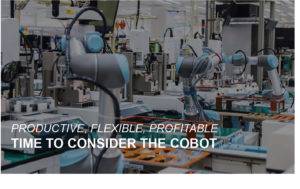 CIMTEC engineers have known that the benefits of collaborative automation are undisputed – more profitability, productivity, flexibility, higher quality, and even more employee satisfaction. Given the current economic landscape, manufacturers need these advantages now more than ever. Our customers’ production lines have proven to be more efficient– and a competitive weapon for combating the pressures and uncertainties of today’s market.
CIMTEC engineers have known that the benefits of collaborative automation are undisputed – more profitability, productivity, flexibility, higher quality, and even more employee satisfaction. Given the current economic landscape, manufacturers need these advantages now more than ever. Our customers’ production lines have proven to be more efficient– and a competitive weapon for combating the pressures and uncertainties of today’s market.
If you’ve considered deploying cobots but haven’t yet, or are thinking about increasing automation in your factory, the time is now. Here are the top three reasons why:
1. LABOR SHORTAGES
The top challenge manufacturers face is the gap between the demand and availability of workers. Unfortunately, the labor shortages will only get worse in the coming years. In fact, research from Deloitte and The Manufacturing Institute found that over the next 10 years, manufacturers will need to add approximately 4.6 million manufacturing jobs – 2.4 of which may go unfilled.
Complicating the issue further is the aging workforce: workers aged 55-74 accounted for 85% of employment growth in the eurozone between 2012 and 2018, and 44% of U.S. manufacturing workers are at least 45 years old. As these workers continue to near retirement age, filling open positions from a shrinking talent pool will get even more challenging.
Cobots can help ease the burden by filling the labor gaps. Cobots can be programmed, operated, and maintained by existing employees, regardless of the team’s previous robotics or automation experience. In fact, the out-of-box experience for an untrained operator to unpack a UR robot, mount it, and program the first simple task is typically less than an hour.
By providing manufacturers with an easy way to automate the dirty, dangerous, dull, and repetitive jobs, organizations can shift existing employees to new and more valuable roles, which increases employee satisfaction and builds morale and loyalty. In a 2019 report on the consumer packaged goods industry, McKinsey found that extensive automation can ease recruitment and retention by creating new technical roles with better pay, opportunities, and working conditions.
Operationally, cobots can work around the clock and don’t need to take breaks or vacations – they pick up slack when organizations are short-staffed, and increase productivity for existing workers, especially in high-volume production environments.
2. OPERATIONAL FLEXIBILITY AND FINANCIAL ADVANTAGE
In addition to labor shortages, today’s manufacturers face intense economic and political uncertainty. Adding to the complexity, today’s consumers increasingly demand higher quality products and real-time availability – at lower costs. These pressures make running a profitable production line more challenging than ever before.
Cobots can make companies of any size – and in any location – competitive by providing the flexibility they need to compete, grow, and profit in any economic climate. Collaborative automation equips organizations to easily scale up or down, switch SKUs, and expand into new markets more quickly.
Unlike costly industrial robots, cobots are affordable, versatile, and easy to integrate into work processes without the need for major renovations or costly installation projects. They are lightweight, space-saving, and easy to re-program and re-deploy to multiple applications as new needs arise, without changing the production layout.
Financially, collaborative automation has a direct impact on profits: In fact, a 2019 study by UK-based research firm Smither Pira found that a 1% decrease in production cost delivers a 34% increase in profit. Further, cobots play an important role in improving product quality by reducing human error commonly associated with dull, repetitive, and dangerous tasks, ensuring consistency and accuracy, and enhancing the ability to create more complex goods – which satisfies customer demand for higher-quality goods at lower costs. At the same time, with the right configuration, a cobot can produce finished goods at a much faster rate than hand-crafting or assembly lines. Examples of increased quality – and efficiency – can be seen across the world: Tribar Manufacturing, a Tier 1 automotive supplier in the U.S., achieved 100% quality and reduced cycle times by 50% through its application of cobots.
3. YOU CAN AFFORD IT. WE PROMISE.
Few would argue with the benefits of collaborative automation. But if you’re a small- or mid-sized manufacturer, you’re probably asking yourself, “can I afford such a solution with all the pressures facing my factory and the looming economic uncertainty?” Or, maybe you’re thinking: “That’s great – but my capital equipment budget is tapped out.”
Now, you can immediately put cobots to work without the upfront capital investment. Whether you are starting your automation journey, looking to upgrade your current cobots, or ready to increase automation in your factory, our new robot rental program helps you grow your business without dipping into cash reserves.
CIMTEC understands the challenges facing your business today and we are ready to help. Let us show you a demo and you will want to start taking advantage of the benefits of automation right now, without worrying about capital expenditures.
Let one of our engineers show you a demo of these hardworking robots, call us at 877.524.6832 or email sales@cimtec.com

